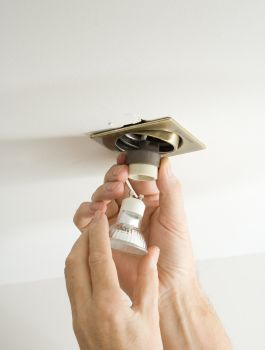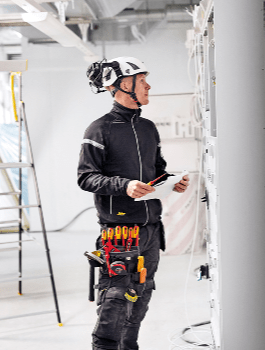Before you begin...
Always Do It Safely:
- Turn off the main power at the fuse box/consumer unit. Remove the circuit fuse to isolate the circuit you’re going to work on. Put the circuit fuse in your pocket to avoid someone accidentally replacing it and you working on it!
- Alternatively, switch off the breaker and lock it if possible
- Put a note on the unit advising that you are working on this circuit
- Check to make sure that the circuit is disconnected using a socket tester or, for lighting circuits, a voltage tester/meter.
If you choose to add more outlets or switches to an older house yourself then be sure to use products that are designed for easy installation. Using a 1-gang to 2-gang socket converter will enable you to do this.
 When an extra socket needs to be installed it involves adding a spur from a ring circuit which can either be run from an existing socket, or from a junction box connected into the cable run of a suitable ring circuit. The circuit must always have RCD protection.
When an extra socket needs to be installed it involves adding a spur from a ring circuit which can either be run from an existing socket, or from a junction box connected into the cable run of a suitable ring circuit. The circuit must always have RCD protection.
Adding A Spur To A Ring Socket
Connect into a ring circuit by running a spur cable from the terminals of an already existing socket. You can't, however, connect it to just any socket, IEE Wiring Regulations state clearly that you can’t run a spur from a socket that's already on a spur, or that already provides a spur. Also, the new socket mustn’t extend the floor area served by the circuit beyond the recommended limit of 100 metres squared.
Always consult a qualified electrician if in any doubt.
IF you don’t want to run a spur from an existing socket it can also be run from a 3-terminal, 30-amp junction box which is wired into the main circuit cable. The same regulations apply so, again if in doubt ask a qualified electrician.
Take into account your floor area
IEE Wiring Regulations allow you to have an unlimited number of socket outlets on each main circuit which runs from your consumer unit, there are restrictions on the area of floor which each circuit can supply. A 30/32 amp ring circuit supplies a maximum area of 100 metres squared. However, ring circuits serving kitchens and utility rooms are usually the most heavily loaded so it's best to stay clear of extending them into other rooms when possible. Generally, the rooms of the house covered by each circuit are printed inside the fuse cover of your consumer unit, but it can be checked by isolating the circuit and checking that every socket works using a socket tester.
Once you've found the extent of the circuit measure the rooms that it supplies and calculate the area of the floor. If it’s a big house and you were planning to feed a socket in a different room by running a spur through a wall, you might find that it exceeds the limit. If this is the case, you'll have to run the spur from another circuit.
Saving Energy
An intelligent multi-socket adapter has a 'master' socket and a number of 'slave' sockets. When the adapter recognises that the device plugged into the master socket has been turned off, it automatically turns off the slave sockets too - saving you energy. As soon as you switch on the master appliance put the slave sockets switch back on, e.g. you could plug your television into the master socket and your home cinema and DVD into the slave sockets. In a home office, your computer could be plugged into the master socket while the printer, scanner, and other secondary devices would be plugged into the slave sockets.
Running A Spur From A Socket
To begin with, install your new socket, running a length of 2.5mm two-core-and-earth cable from the new outlet to the existing socket.
Step 1
Isolate the circuit, then use a voltage tester to double-check that the existing socket isn’t live.
Step 2
Remove the faceplate of the new socket, and feed the cable into the mounting box via a rubber grommet, then attach its cores to the faceplate terminals. Remember, add green/yellow sleeving to the bare earth core of the new cable, and ensure the terminal screws are as tight as possible.
Step 3
Cut the cable, and then do the same thing at the existing socket.
Step 4
With metal faceplates, cut a short length of earth core from 1.5mm² cable, and run it in between the earth terminals of the faceplate and mounting box.
Step 5
Put the faceplate back and then turn your power back on. Finally, using a socket tester, check your new socket is wired correctly.
correctly.
Running A Spur From A Junction Box
Begin by installing the spur socket, then run a length of 2.5mm² two-core-and-earth cable back to the point where it’s to be connected to the main circuit cable. Ensure the junction box has the same amperage as the circuit.
*Here’s A Top Tip - Know the terminals*
Ensure that you're connecting to the right socket terminals - their position will vary between brands. Take the time to read all instructions that come with your new socket.
*Safety Tip - Grommets*
 When using metal mounting boxes fit rubber grommets to protect the incoming cable from damage by the sharp edges around the metal cut-outs.
When using metal mounting boxes fit rubber grommets to protect the incoming cable from damage by the sharp edges around the metal cut-outs.
Step 1
Isolate the circuit, then double-check it isn’t live with your socket tester.
Step 2
Loosen the faceplate of the new socket, feed the cable into the mounting box via a rubber grommet and connect its cores to the terminals of the faceplate. Remember, add green/yellow sleeving to the bare earth core of the new cable, and make sure the terminal screws are as tight as possible.
Step 3
With a metal faceplate, cut a short length of earth core from 1.5mm² cable and run it between the earth terminals of the mounting box and the faceplate. Put the faceplate back.
Step 4
Screw the base of the junction box on to the side of an adjacent joist, or to a batten nailed between the joists. This way it'll be within reach of the cut ends of the main cable.
Step 5
Cut the cable and strip back the outer sheathing (make sure it extends a few millimetres into the junction box). Expose the ends of the cores and attach them to the terminals of the junction box. Connect all the cores of the spur cable to the terminals which match - live to live, neutral to neutral, and earth to earth. Don’t forget to add green/yellow sleeving to the bare earth cores.
Step 6
Check that the terminal screws are tight, then put the cover of the box back and turn the power on. Remember, using your socket tester, ensure the socket is wired correctly.
Disclaimer: Please Note You should always get a competent professional to carry out relevant works. When this is Electrical work we would recommend using an *approved electrical contractor. Safety is always the most important aspect of any job so we always advise adhering to this information. Any information or 'advise' we provide is provided on the basis you will only carry out any works if you are ^competent and *approved in this field. If you are not ^competent and *approved in the field of work you are trying to do you are doing so at your own risk.
*Approved by NICEIC or equivalent.
^Competent - Has relevant experience or qualification in this field of work

 Hate
Hate
 Dislike
Dislike
 Neutral
Neutral
 Like
Like
 Love
Love





















